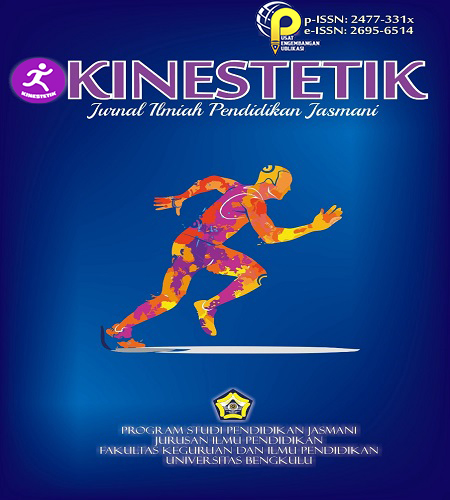Main Article Content
Abstract
Children with mild ID are also referred to as debilitating or able to educate. Children with a mild ID can receive education like other normal children. Most of the Children with mild ID experience delays in physical development that have an impact on basic movement skills problems such as locomotor movements of running, jumping and jumping, as well as manipulative throwing and catching an object. The purpose of this study is to develop a learning model through V2 playmat games which are designed and developed to stimulate basic movement skills in children with mild ID in the Adaptive Physical Education learning process. The subjects of this study were children with mild ID aged 8-12 years totaling 10 people in the narrow-scale trial and 25 people in the wide-scale trial. Involving 3 experts consisting of learning media experts, learning material experts and Physical Education practitioners. The method used in this research is the Lee and Owens Analysis, Design, Development Implementation, and Evaluation (ADDIE) research and development method. The results of the validation test by experts using the Content Validity Index (CVI) and Content Validity Ratio (CVR) tests which show an average CVR value of 0.27 in other words the Playmatt game model developed is appropriate or relevant, or good and also has high content validity. in improving basic movement skills, cognitive, and mild ATG pleasure.
Keywords
Article Details
Copyright (c) 2022 Bayu Hardiyono

This work is licensed under a Creative Commons Attribution-ShareAlike 4.0 International License.
Authors who publish in this journal agree with the following terms:- Authors retain copyright and grant the journal right of first publication with the work simultaneously licensed under a Creative Commons Attribution-ShareAlike 4.0 (CC BY-SA) that allows others to share the work with an acknowledgement of the work's authorship and initial publication in this journal.
- Authors are able to enter into separate, additional contractual arrangements for the non-exclusive distribution of the journal's published version of the work (e.g., post it to an institutional repository or publish it in a book), with an acknowledgement of its initial publication in this journal.
- Authors are permitted and encouraged to post their work online (e.g., in institutional repositories or on their website) prior to and during the submission process, as it can lead to productive exchanges, as well as earlier and greater citation of published work (See The Effect of Open Access).
- This work is licensed under a Creative Commons Attribution-ShareAlike 4.0 International License.
References
- Aina, S.I. Adegboro, J.S. Ayenigbarar, C.O. (2018). Drugs, Substance Use and Abuse. Benni city: Ambik Press. Pp. 141-142.
- Alfred, A.A. (2003). Adolescents in Africa. Ibadan: Hadassah publishing limited. P. 10.
- Aristidis, V., Roupa, Z. & Konstantinos, G. (2011). The Influence of advertising Messages on the Smoking Habits of Teenagers. Pneumon. 2 (24), 188-193.
- Cardio Smart. (2017). Smoking and Heart Disease. https://www.cardiosmart.org/Healthy-Living/Stop-Smoking/Smoking-and-HeartDisease#:~:text=But%20smoking%20cigarettes%20also%20affects,are%20leading%20causes%20of%20stroke. Access 20th January 2020.
- Ene, O.C. (2004). Health Wellness and Longevity. Enugu: Cheston Agency. P. 10.
- Frances, S.W., Eleanor, N.W. & Linda, K.D. (1999). Health Making Life Choices. New York: West Educational Publishing. Pp. 372-376.
- Fredrick, O.S., Olukunmi, L.O., & Akintayo, O.O. (2014). Emerging and Re-emerging Issues in Health Promotion for healthy Living. Ibadan: Isru Educational Services. Pp. .61-63.
- Isiaka, M. & Issah, M. (2015). Incidence of Drug Abuse and Violence among the Youths in Ilorin Metropolis. Journal of Intellectual Scientific and Cultural Interest. 18 (1), 1-5.
- Jude, E.. & Chuks, E.E. (2017). Substance Use Risk Behaviours of Secondary School Teachers in Enugu Education Zone, Enugu State, Nigeria. Journal of Human Kinetics and Sports Science, University of Benin, Benin City, Nigeria. 5 (3), 10-18.
- Meg, A.E. (2015). Drug, Alcohol and Tobacco Education. Owerri: Hephzihab. Pp. .131-133.
- Musa, Y.Q. (1993). Issues in Drug Use and Abuse. London: Tavistoch publication. 10.
References
Aina, S.I. Adegboro, J.S. Ayenigbarar, C.O. (2018). Drugs, Substance Use and Abuse. Benni city: Ambik Press. Pp. 141-142.
Alfred, A.A. (2003). Adolescents in Africa. Ibadan: Hadassah publishing limited. P. 10.
Aristidis, V., Roupa, Z. & Konstantinos, G. (2011). The Influence of advertising Messages on the Smoking Habits of Teenagers. Pneumon. 2 (24), 188-193.
Cardio Smart. (2017). Smoking and Heart Disease. https://www.cardiosmart.org/Healthy-Living/Stop-Smoking/Smoking-and-HeartDisease#:~:text=But%20smoking%20cigarettes%20also%20affects,are%20leading%20causes%20of%20stroke. Access 20th January 2020.
Ene, O.C. (2004). Health Wellness and Longevity. Enugu: Cheston Agency. P. 10.
Frances, S.W., Eleanor, N.W. & Linda, K.D. (1999). Health Making Life Choices. New York: West Educational Publishing. Pp. 372-376.
Fredrick, O.S., Olukunmi, L.O., & Akintayo, O.O. (2014). Emerging and Re-emerging Issues in Health Promotion for healthy Living. Ibadan: Isru Educational Services. Pp. .61-63.
Isiaka, M. & Issah, M. (2015). Incidence of Drug Abuse and Violence among the Youths in Ilorin Metropolis. Journal of Intellectual Scientific and Cultural Interest. 18 (1), 1-5.
Jude, E.. & Chuks, E.E. (2017). Substance Use Risk Behaviours of Secondary School Teachers in Enugu Education Zone, Enugu State, Nigeria. Journal of Human Kinetics and Sports Science, University of Benin, Benin City, Nigeria. 5 (3), 10-18.
Meg, A.E. (2015). Drug, Alcohol and Tobacco Education. Owerri: Hephzihab. Pp. .131-133.
Musa, Y.Q. (1993). Issues in Drug Use and Abuse. London: Tavistoch publication. 10.
